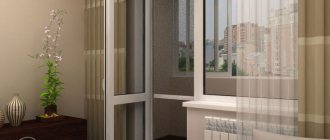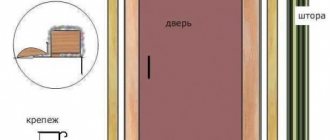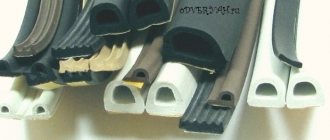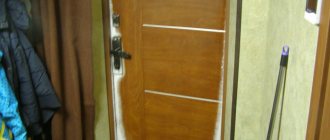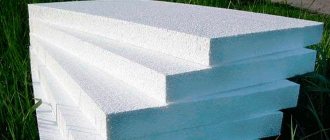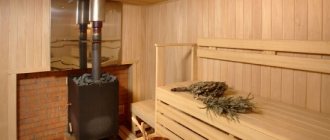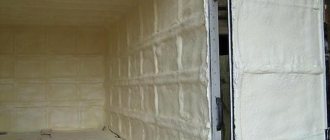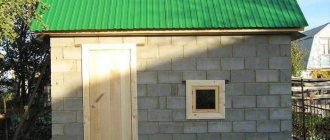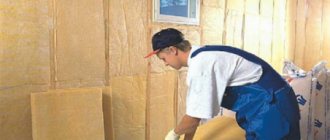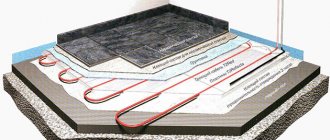To reduce heat losses in the room, a number of measures are carried out, among which the main one is the insulation of the doorway and door leaf. The range of materials requires a more thorough study of the varieties in order to select a more suitable product and create the most comfortable microclimate in the home.
When purchasing a door, be sure to check what type of insulation is placed inside the door leaf and whether it has soundproofing properties, which is important for an apartment building.
Choice of insulation
There are four most popular materials used in insulating balcony doors:
- expanded polystyrene;
- isolon;
- foam;
- mineral wool.
Previously, plastic wool was used, but if more modern materials are available, it is not worth choosing. Such cotton wool easily absorbs moisture, due to which small insects, mold, and fungus grow in it. In addition, the layers themselves can shift over time, which greatly spoils the appearance.
Isolon is a thin, but at the same time, effective insulation
The most popular insulation nowadays is foam rubber. Its main advantages: low cost and ease of use. Glue or nails are sufficient to secure the layer. However, when insulating doors with foam rubber, a repeat will be needed after a couple of years, because the material will begin to crumble due to moisture.
Mineral wool is more often used in wall insulation. It has good insulating characteristics, and such wool does not burn, and the layers are convenient to install. But this is a difficult material to work with, it crumbles and the dust irritates the mucous membranes and skin. Because of this, special protective measures are used during installation, the room is thoroughly cleaned after installation, and the mineral wool itself must ultimately be securely hidden under the finishing. In addition, like plastic wool, mineral wool is deformed under the influence of moisture.
Izolon has a high thermal insulation effect, while the layer thickness required is small, and does not have pronounced functional disadvantages. The main disadvantage of this modern material is its high price.
Which insulation for the front door is better?
There are many materials that can solve the problem of insulation, here are just some of the widespread ones:
- Expanded polystyrene. Inside this material there are many micropores with air, due to which the thermal insulation characteristics of the door leaf remain high. The upholstery base does not play a role in this case.
- Polyurethane foam. It is considered optimal among other solutions existing today. It is used both in rural areas and inside city apartments. But this material is expensive, and moreover, it is difficult to apply to wooden surfaces.
Related article: Decorating interior doors - an original approach to interior decoration
- Izolon. This is a type of polyethylene foam, a member of the group of ordinary foam rubber. The cost of the material is also high, but the result pays for all the costs.
- Mineral wool. This is a material that guarantees thermal insulation performance at a fairly high level. The only disadvantage we can highlight is the ability to accumulate moisture. In addition, mineral wool may sag over time.
- Foam rubber. This is a type of porous material available to almost everyone. The ease of installation makes it popular even among those who live in rural areas. The most budget-friendly type among insulation materials, it can be installed even on the street part of the structure.
- Styrofoam. An ideal solution if you need to insulate the entrance structure from the inside. It is distinguished not only by its low cost, but also by the fact that even over many years it does not change its original appearance.
Insulation and door upholstery video
We bring to your attention a video on the topic of our article about the insulation of wooden and plastic balcony doors. In the video, using the example of an entrance door, you will see how easily you can insulate the door from the outside with your own hands using foam rubber.
To prevent cold air from entering the room from a loggia or balcony, it is necessary to eliminate all cracks, including those in the doors. Modern metal-plastic models provide a sufficient level of tightness, but during prolonged use their fabric no longer fits tightly to the box, which leads to heat loss.
If the door leading to the balcony is wooden, then over time the wood dries out and the cold enters into the resulting cracks almost unhindered. In such situations, it is necessary to insulate the balcony door, often with your own hands.
Materials for insulation
Door insulation not only retains heat, but also acts as sound insulation for doors, this is especially important in an apartment building. Therefore, when choosing a door, you should pay special attention not only to its finishing material, but also ask what kind of insulation it has in the door leaf.
And if you are making a door with your own hands, then you need to correctly decide which door insulation to choose.
Door insulation scheme
Honeycomb door filling
This kind of material is quite common. It gets its name from the installation method, which is performed as a honeycomb.
So:
- This material not only makes the door insulated , but also provides excellent sound insulation. It has gained popularity due to its low cost, its price is much lower than its analogues;
- The main manufacturing material is corrugated cardboard . This is an environmentally friendly material that will not harm human health;
- Tolerates temperature changes and high humidity perfectly. Suitable for insulating the front door;
- This material has quite high rigidity and resistance , both horizontally and vertically;
- Also speaking in its favor is the low weight , which will not affect the door hinges.
Mineral wool
This material is made from mineral raw materials. It has quite good performance in noise and heat insulation.
Basalt door insulation is mineral wool:
Using mineral wool in door insulation
- It will not be harmed by high humidity and temperature changes;
- A fairly high service life also speaks in favor of this material;
- Its high environmental friendliness also speaks in its favor;
- The low price also attracts consumers;
- There is one drawback: it shrinks over time and after that there will be voids in the canvas.
Attention: when insulating a door with mineral wool, you should install additional stiffening ribs that will prevent the material from sagging. Moreover, the installation base should be coated with glue.
Let's look further at which insulation to choose for the door.
Foam insulation
Door insulation with this material is done most often. You can see this in photos and videos. This design has many advantages over other materials.
Using foam plastic to insulate a door
So:
- Such a door will have excellent soundproofing characteristics;
- Moreover, this material is environmentally friendly and does not harm human health;
- Fairly simple installation. All this can be done entirely with your own hands, which will significantly reduce the price of the entire structure;
- Light weight will not cause the door to sag. Also, this material does not shrink over time and serves as an excellent insulation material;
- The price of the material itself is quite low and anyone can afford it;
- There is one drawback, it is susceptible to fire. When exposed directly, foam releases rather toxic odors.
Insulation with polyurethane
Door insulation polyurethane foam is not used very often. But when choosing a material, it should also be considered.
This is a completely synthetic material, which has its own advantages:
- This filler is not very heavy, which is important when finishing the door;
- With its help, you can perfectly and evenly fill all the voids in the door;
Attention: This material is not easy to install. You just need to do this only with a special nozzle or spray bottle. And these are extra costs.
- This is a fairly rigid insulation, where the cells are filled with gas;
- Tolerates temperature changes and high humidity perfectly. Can be installed on entrance doors.
Foam propylene plates
This material has all the positive qualities of the listed materials:
- Manufacturing a structure using this material will perfectly provide both heat and sound insulation;
- It is not subject to stretching and compression, therefore it does not shrink over a long period of time;
- It is not affected by temperature changes and high humidity;
- It is possible to install it yourself and it looks attractive in the eyes of consumers.
Insulation of a wooden door
Insulation of a wooden door leaf is carried out in several stages:
- Making blanks for special rollers from foam rubber and leatherette or other durable material. The number of rollers depends on where the door opens: inward - 4 pieces, outward - 3. They will need to be nailed on all sides of the door, except for the connecting one, so one is made equal to the height, and two to the width. This eliminates the problem of a loose fit. Leatherette strips should be 14 cm wide, and foam rubber strips should be 3 cm wide.
- Making the canvas that will cover the door. A piece of leatherette is cut to the size of the canvas with an allowance of 10-15 cm, and foam rubber or other insulation is cut exactly to the size of the door.
- Preparing the door leaf. It consists of removing the door and all the fittings from it.
- Nail the finished rollers next to the corresponding ends. To do this, a strip of material is laid next to the door leaf, face down, insulation is placed on top, the material is wrapped and nailed.
- The prepared insulation sheet is nailed with small nails (or attached with glue), and leatherette is laid on top and secured with furniture nails. Additionally, nails are driven into the canvas according to an invented pattern; this is necessary for better fastening of all layers.
A wooden door can be insulated with foam rubber
If the door has windows, it is better to replace the glass with double-glazed windows. Such services are provided by many companies involved in the installation of plastic windows. All through cracks must be treated. This can be done using putty, sealant, and adhesive foam sealant. If the cracks are small and in the door leaf itself, a simple painting may be sufficient.
You will learn about the repair of plastic balcony doors from this article.
How to insulate a wooden balcony door
Required materials and tools:
- leatherette strip;
- insulation;
- small nails;
- furniture nails with a wooden head;
- hammer;
- carpenter's knife.
Sequence of work
1 For convenient work, it is advisable to remove the door leaf from its hinges and lay it horizontally on any supports, for example, on a couple of stools. 2 Remove the handles and other protruding parts. 3 We prepare the basis for the preparation of rollers, which we will use to cover the cracks around the door leaf. If it opens outward in relation to the room, then it is necessary to cut out three strips of leatherette about 14 cm wide. One is equal to the height of the door. The other two are along its width. If a wooden door is opened inward, then you need to prepare one more strip, because you will need to use rollers to cover all possible cracks around the perimeter of the door leaf. To fill them, you need to cut strips of foam rubber 4 cm wide. 4 Place the cut strips of leatherette face down on the doors. Using regular nails, we attach strips of decorative material to its edge along the entire perimeter. 5 Place the cut foam rubber on the strip located at the bottom of the door. Having wrapped it in leatherette, we nail the resulting roller to the door leaf. 6 Now you need to cut out a panel of leatherette for the decorative upholstery of the door. Its dimensions should correspond to the full area of the door leaf with a small allowance (about 10 cm) on each edge of the door. To save money, you can use old raincoats and leather jackets to decorate the door. To do this, parts of various shapes and sizes are cut out of them, for example, in the form of a rhombus or rectangle. You can diversify their appearance using leather paint. 7 Place foam rubber on the surface of the door leaf. To prevent it from sliding down after a while, it is advisable to place it on glue. 8 We cover the insulation on top with an upholstery panel, which we nail to the wooden base of the door using carpentry nails with a decorative head. We begin fixing the panel along the height of the door, then below and above. When fixing the facing panel, it is necessary to ensure that it does not warp and wrinkles do not form on it. 9 Now all that remains is to make and secure the remaining rollers
When installing them, you need to pay attention to the fact that the strip of leatherette with the top layer overlaps the edge of the bottom one. 10 To create a more exclusive look for the door, it is advisable to use furniture nails with a decorative head to punch through some pre-designed pattern.
How to insulate a wooden door to a balcony
The most popular reason why the cold comes in is a wooden door to the balcony. Although the wood panel itself retains air remarkably well, thin panels are usually used to make doors. Before you begin directly with insulation, you need to figure out what specific defects you have to deal with. Most often, joints and fabrics are sealed, and slopes are also sealed. Experts advise insulating a wooden door comprehensively to achieve the maximum level of efficiency.
The first thing you need is to select the necessary set of materials and tools. Very often, plastic wool is used as a sealant, but it has a significant drawback - it absorbs moisture and promotes the development of microorganisms. In addition, the operational process leads to displacement of the wool under the skin, and this reduces efficiency and worsens the appearance. Another material that will allow you to insulate a balcony door is foam rubber. The installation procedure involves fixing the foam rubber to the surface using glue or nails. Unfortunately, the presented material is short-lived; after 2-3 years it will begin to crumble due to high humidity. Isolon is considered a more modern insulation; it allows you to achieve noticeable thermal insulation characteristics.
Insulating a balcony door, in addition to seals, requires wood putty, building mixtures, a level, spatulas, a set of ordinary construction tools, a tape measure and a sharp knife.
Stages of work that will eliminate the penetration of cold into the room:
- Removing old paint, conducting a careful inspection of the canvas, determining the reasons for the entry of cold air. Seal the holes between the panels with putty.
- Disassembling the canvas, unscrewing handles, hinges and other accessories. Then you should place the door on the floor or table, take the upholstery and attach it to either side of the canvas. The upholstery should be larger than the insulated part of the door. Here you can’t do without special nails with wide heads. Then you need to fix the foam around the entire perimeter of the door.
- Stretching the upholstery onto the canvas. To do this, fixation is performed from the fixed edge. The gap between the nails should be 16-20 cm. The edges of the upholstery are folded so that the fabric can be cut off inside. The balcony door can be sealed from the inside or both.
Then you need to take the foam rubber and cut 3 strips, their width should correspond to the thickness of the door. 2 strips in length coincide with the width of the canvas, and 3 - with its height. After this, you need to prepare 3 strips of leatherette with a length corresponding to the height of the canvas, and a width of 12-15 cm. The material must be nailed on three sides along the door edges.
In addition, you can create a protective seal using rolled beads. The cut piece of foam rubber is wrapped in dermatin strips and fastened with furniture nails so that they can cover the gaps between the canvas and the box on three sides. At the end of all manipulations, the canvas is returned to its original position, and if desired, sealing tape is glued to the joints.
Insulation of metal doors
Metal doors can create so-called cold bridges. Frost creeps through them into the room, even if the door leaf is completely sealed and closes tightly. Therefore, the purpose of insulating a metal door is the following:
- increasing door sealing;
- insulation of all metal parts of the product, except for the door handle;
- placing insulating material inside the door leaf.
The design of almost all metal doors is hollow. Thanks to this, it is very easy to place mineral wool or a foam board inside as insulating material.
So, the process of insulating metal doors will look like this:
- Carefully remove locks and door handles;
- Disassemble the box (if the fastening is carried out using welding seams, they must be removed with an angle grinder);
- Lay the insulation inside the empty box;
- Assemble the door structure to its original position.
If you choose foam plastic to insulate the door, then gaps will appear between the sheet and the fastening and fixing metal profiles. In order to ensure complete thermal insulation, fill these spaces with polyurethane foam.
If you have a non-removable door, it can be insulated using an additional internal lining. To do this, remove the door from its hinges, remove handles, locks and other adjustment fittings. Screw a beam with a diameter of 10 X 10 mm around the perimeter of the door leaf from the inside, stretch the upholstery for the entrance doors and secure it to the beam with special nails.
Materials and preparatory work
In order for the door to look not only beautiful, but to serve as an insurmountable barrier to the cold, you need to select a suitable insulation composition, prepare the tools and necessary materials , depending on the base with which the work will be done:
- Construction stapler.
- Jigsaw.
- Pencil or felt-tip pen.
- Self-tapping screws.
- Roulette.
- Polyurethane foam.
- Liquid Nails.
- Drill with reverse.
- Insulation for doors and sealing seams.
- Material for decorative finishing.
- Fiberboard.
- Stationery knife.
In order to properly insulate the door, before starting work, it must be removed from the hinges and placed on a flat surface, all fittings must be dismantled (door handles, locks and other parts). In the case when it is made of chipboard sheets, similar materials or iron, one of the parts will need to be removed so that there is access to fill the cavity.
After removing the previous coating, treatment with an antiseptic is also important; this is done in order to destroy bacteria that have grown under the old casing and extend the service life of the door. Then the surface is degreased and insulation begins.
Progress
First, the insulation should be cut, when the entire fabric is subjected to the procedure, the piece is cut to its size . In the case of a prefabricated model, it is cut to the size of each section.
Having laid out the insulation on the plane of the door, its joints are treated with polyurethane foam. And so that it does not slip, it is attached with a stapler.
Exterior finishing
There can be several types of exterior door decoration: usually an elastic material is used, for example, leather or its substitutes. The material must be cut with a margin of approximately 10 cm on each side. To ensure the tightest fit of the door and to close the cracks around the perimeter, small lining rollers are formed .
Then the insulation and bolsters are covered with upholstery, the edges are folded, and it is thoroughly secured. It is preferable to use furniture nails with beautiful and wide heads for these purposes. They securely hold the insulation and leatherette and look aesthetically pleasing if you place them at the same distance and come up with an interesting pattern.
If for some reason you are not satisfied with the soft upholstery, then you can use a sheet of fiberboard or plywood. Then you need to cut out a fragment corresponding to the area of the door and nail it with nails with small heads. Then the surface must be carefully puttied and the final finish can be glued in the form of veneer, film or laminate . This is done using an iron, as they have a hot-melt adhesive base.
At the final stage, the fittings are returned to their place.
Reasons why cold gets into a room with a balcony block
A standard door to a balcony or loggia can be of two types: with full glazing and partial, when the panel at the bottom is covered with a plastic shield. A design with incomplete glazing is warmer - plastic has much lower thermal conductivity than window glass.
Before insulating the balcony door, you should identify the places through which the cold penetrates into the room. The main ways that cold air enters the apartment are places of defects or individual elements of the balcony block:
- Glazing for a balcony door. The lowest protection against cold is provided by ordinary sheet glass and large-area single-chamber double-glazed windows (fully glazed balcony door).
- Gaps between the canvas and the box. If the insulation loses its performance qualities, gaps may appear between the sheet and the frame, and cold air will enter the room.
- Loose fit of the door leaf to the frame. If the door has moved away from the frame, then a gap may appear in the hinge area that the seal cannot close - cold air will flow through it.
Rice. 2 Scheme of installation and thermal insulation of the balcony block
Poor quality assembly of the balcony block. Typically, a block for a balcony is assembled by connecting two parts - a window frame and a door frame. To do this, a sealing strip is laid between the walls to be connected or foam is applied to the surface, then both parts are connected with metal screws. If the seal was not applied or the screws came apart during installation, then cold air will penetrate into the gap between the frame of the door leaf and the window block. Poor quality installation of the balcony block in the opening. Sometimes it happens that for the sake of savings or a shortage of mounting foam, the balcony block is fixed in the opening not with a continuous strip of foam, but in separate sections. Also, polyurethane foam can decompose and crumble over time, and if the block was installed without a vapor barrier tape, cold will enter the room through the empty space. In this case, outside air enters the room through the gap between the external slope and the frame of the balcony block. Another reason for the penetration of cold air into the room is a violation of technology. The plastic frame has poor adhesion with cement mortars used for external slopes. When installed correctly, a pre-compressed self-expanding sealing tape (PSUL) is glued around the perimeter of the balcony block box from the outside, which seals the gap between the outer slope and the frame of the balcony block. In its absence, due to poor adhesion of the plastic with the cement surface, cold air will flow through the gap between the slope and the block box.
Rice. 3 Adjusting the web pressure and its distance from the box
What can be done to insulate the door?
Wooden door leaf
Heat loss through the door occurs in only 2 ways:
- During cold winters, heat is lost through the cracks around the door leaf. It is difficult to imagine a completely sealed entrance to an ordinary apartment. Therefore, getting rid of a draft, which most often occurs due to a loose fit of the canvas to the box, is quite difficult.
- Another way of heat loss is through the door leaf. The thermal conductivity of wood is low compared to metal, but even a Chinese steel door turns out to be more reliable in terms of protection from the cold. This is due to its design, which includes a mandatory layer of thermal insulation.
To insulate a wooden entrance door with your own hands, you must eliminate both causes of cold penetration at once.
How to insulate entrance doors
The plastic structure, by and large, is a frame made of a supporting metal-plastic profile with plastic or glass inserts. The first ones, as a rule, are arranged according to the sandwich principle and include a thermal insulation layer. Glass windows are designed as hermetic windows: a mixture of inert gases is pumped between the panes, which act as insulation. That is, the design, in principle, ensures heat retention in the room.
It is important to achieve not only thermal insulation of the door block itself, but also the tightness of the structure, that is, a tight fit. The entrance insulated plastic door is covered around the perimeter with a sealing rubber tape
For greater density, it is recommended to lubricate the tape with a special lubricant.
It is possible and necessary to insulate plastic doors for the winter in a private home based on the cause of heat loss.
Oddly enough, the first factor here is glass inserts. Despite the tightness of this design, glass itself does not help retain heat in any way. The heat insulator is air, an inert gas, or even a vacuum between the glasses. The main reason for the dysfunction of such a gasket is a violation of the tightness, for example, when the sealant is damaged. In this case, you need to replace the glass inserts on the entrance leaf with sealed ones.
To make a street door of this type insulated, you can install energy-saving glass. They retain heat better under any circumstances, but this solution is more expensive.
The second reason is poor sealing of gaps during installation. Such cracks need not just be closed, but thermally insulated and carefully sealed. To fix the situation with your own hands, you need to remove the mounting foam by clearing the gap. Then you need to fill the gap as tightly as possible with polystyrene foam, and then foam or plaster.
In your own home, you do such repairs yourself, since there is nothing complicated about this work. In an office building, renovations are, of course, carried out by specialists.
The third reason, equally common in both a private home and an office building, is sagging street doors. Over time, any product wears out and this fully applies to a plastic door. In this case, insulating for the winter means adjusting the sash.
First, they determine exactly how the door sagged, since in appearance it may be completely invisible. Consider the seal: in places of displacement it will be more strongly crushed or even damaged. Having correlated the location of the damage with the displacement of the entrance leaf, they begin to make adjustments in order to make the door insulated.
So, if the upper corner of the sash has shifted and no longer fits tightly, use a hex key to tighten the screw on the top hinge, having first removed the plug from it. If the bottom corner sags, do the same with your own hands with the bottom loop.
In cases where the street sash falls down under its own weight, vertical adjustment is carried out: to do this, turn the screws on the lower hinges clockwise.
How to insulate the roof of a house from the inside, features of thermal insulation
Agree, it is not always advisable to insulate the ceiling from the inside - if you have low ceilings, then there is little point in this. Moreover, it is not very convenient to do such thermal insulation - it is much easier to putty the ceiling and give it an attractive look by painting. It is more logical to insulate the upper part of the house from the attic side - this is where you can simultaneously insulate both the ceiling and the roof, thus creating a reliable barrier to heat escaping from the house.
- The ceiling is also the floor in the attic. The option is the same as with the floor in the house. Often the attic will have a wooden floor, and all you have to do to insulate it is fill the crawlspace with insulation. Here you can already use polystyrene foam, but it’s still better not to do this, since apart from being cheap, this material has no advantages.
- Roof. As a standard, it is insulated at the installation stage, but if for some reason this was not done, it does not matter. It’s never too late to solve the question of how to insulate a brick house from the inside, or rather its roof. The same technologies are used here as when insulating walls - you can also add a couple of other options to them. The so-called sprayed mineral wool copes well with the task of insulating the roof - with the help of a compressor and a special device, the fibers of this material are literally driven into the under-roof space. They fill everything, even the most inaccessible places - such insulation requires a vapor barrier.
How to insulate the roof of a house from the inside photo
Subsequently, the insulation is hemmed with panels. In principle, you can leave everything as is, but if you plan to use the attic as a living space, then you cannot do without exterior wall decoration.
In conclusion to the topic of how to insulate a house from the inside in a country house, I will add only one thing - no matter how hard you try, no matter how you insulate the walls, ceiling, floor and roof, the effect will still not be complete if you do not take care of such building elements as window and doorways. They occupy a considerable area of the walls, and significant heat loss occurs through them - this issue must be addressed before insulating the walls. You should also remember about such structural elements that also need to be thermally insulated, such as slopes.
As you know, there is nothing superfluous in insulating a home. Floor, ceiling, walls, windows - everything is subject to careful thermal insulation if you want your apartment to be cozy
And insulating the door in this situation is an equally important concern.
Drafts coming from the front door can cause a lot of trouble. Any structure: wooden, metal, in itself does not save you from the cold. Therefore, additional door insulation is necessary.
We will tell you in this article how to do all the work correctly so that the door faithfully serves to preserve warmth and comfort in your home for many years.
Insulating the front door with foam rubber
If you want to insulate your front door without taking a lot of time and money, use the most familiar, widespread material - foam rubber. It is not suitable for sealing the sides of a door frame, but it can be sewn onto a wooden door on both sides.
To work you will need the following:
- Foam rubber;
- Upholstery fabric;
- Glue;
- Threshold board;
- Slats made of wood and plastic.
- First of all, cut off the outdated covering from the door and get rid of the remaining insulating materials. Wash the surface thoroughly.
- After the door has dried, stick layers of foam rubber cut exactly to size on its inside and outside sides. If necessary, pieces of foam rubber can be glued together in 2-3 layers (for example, if the material is thin, or you think that additional insulation will not harm).
- Now stretch the upholstery material over the foam, securing it to the door with nails or a staple gun. You can decorate the surface with a pattern of wallpaper nails. Do not overdo it: the nails press and press in the insulation, because of this its heat-saving properties are lost.
- Now it's the turn of the door frame. Stuff slats around the perimeter of the door, which were previously covered with foam rubber and fabric. At the same time, control the position of the closed door: it should fit tightly, without gaps.
- The last stage of insulation is installing the threshold. The threshold board should completely cover the gap under the door, but not interfere with the door leaf opening and closing.
Instead of foam rubber, you can use materials such as polystyrene foam (2 to 5 cm thick) or polyethylene foam. In terms of their heat capacity, they surpass any traditionally used materials.
This simple and economical method will help you quickly insulate your door, further protecting you from extraneous noise.
Door insulation
Entrance doors are most often made of two materials: metal or wood - depending on what type of door is installed in your home, the main features of the insulation process will depend. However, all doors have one common weak point - the gap between the door itself and the door frame, through which cold air from the street directly penetrates.
Insulation of the door perimeter
Self-adhesive tube insulation
- No matter how tightly the door fits, there will always be a certain gap between it and the frame . It is not a design defect, as it is necessary for the correct operation of the locking mechanism.
- It is almost impossible to remove the gap by adjusting the door for a tighter fit to the jamb - for this purpose it is more advisable to use a rubber or polymer-based tubular seal.
- First of all, the dimensions of the door are taken - the height and width are measured, which is then multiplied by two. Thus, you will get the length of the perimeter and accordingly find out how many linear meters of insulation you need to buy.
Note! When purchasing insulation, it is advisable to purchase 15–20% more linear meters. This will help you cover various unforeseen expenses - manufacturing defects, incorrect cutting or errors in calculations. The price of the tape is in most cases insignificant, so it will have virtually no effect on the total cost of the purchase.
Seal sticker
- Door insulation for the perimeter has the form of a strip, the width of which depends on the size of the door overlap . Its thickness is selected depending on the size of the gap.
As a sample, you can use a small piece of plasticine wrapped in polyethylene - place it between the frame and the door, and then close it. The thickness of the plasticine plate obtained in this way will be equal to the required thickness of the insulation in a compressed state.
Note! This parameter plays a very important role - an excessively thick tape will lead to the fact that the door will have to be closed with force, which is not very convenient and will lead to wear of the door mechanism, and a thin one will allow cold air to pass through.
The process of installing the tape is quite simple, since it has a self-adhesive base - you need to remove the glossy protective paper and stick it in the place where the door comes into contact with the door frame.
Insulation of an iron door
The metal version of the door most of all needs insulation, since steel has very good thermal conductivity - it freezes through within a few minutes. This is especially noticeable in severe frost - cold air begins to blow from the doorway.
If you have a door with a front steel base and a plastic or metal back, then the insulation can be placed in the middle of the door, since in most cases it is hollow.
The work order in this case will look like this:
Internal door insulation
- First of all, the back cover is removed - in most cases the door has a collapsible design, but if it is welded or riveted, then this will be discussed below;
- Then the insulation - polystyrene foam or expanded polystyrene - is cut to the size of the empty space. In this case, the second option is more appropriate, since it has a denser structure and is not so susceptible to deformation under the influence of heat;
- After the insulation sheets are inserted into the space allocated to them, they are fixed using polyurethane foam. All joints between the sheets of thermal insulation are foamed until a homogeneous structure is created, after which you can begin to reinstall the back cover;
Wooden frame for door
If the front door has the form of a steel sheet, welded with corners or steel strips, then the insulation follows the same scheme as described above, with the difference that you need to make a back cover. It can be made of either metal or a sheet of plywood, which is cut along the contour of the door and screwed with metal screws.
If the door has a solid structure and it is not possible to disassemble it, then a frame of wooden beams is assembled around the perimeter of the door, through which a hollow space and a base for the back cover will be created (which in this case will serve as the front part of the door). The timber is fastened using metal screws.
Note! The screw heads must be “sunk” in the frame so that they do not interfere with the installation of the cover in the future.
Insulation of a wooden door
By itself, wood has poor thermal conductivity, but after prolonged exposure to low temperatures, a wooden door can also freeze. In this case, the most common method of insulation in this case is external upholstery with foam rubber.
The order of work in this case looks like this:
Door removed from hinges
- The door is removed from its hinges and installed in a horizontal position on a hill (bricks, chairs). Then the surface of the door is cleaned of dirt, dust, swollen paint, etc. After which the surface is degreased with alcohol or a similar solution.
- A single sheet of foam rubber is cut to the size of the door. If the door has small side slots, cut out the corresponding side elements, which will be glued simultaneously with the main part. If the gaps are wide enough, then you need to select slats that match the width. Then the foam rubber is glued to the surface of the door with an adhesive composition.
- After the glue has completely dried, a sheet of water-repellent material is cut to the size of the door - dermantin, leather, etc. The dimensions of the sheet are calculated with a certain margin. Then the material is cut to form a frame that will frame the door and mask the ends of the main panel
- Using a stapler, the door is covered with the main blank along the edges, then, if there are large gaps, side slats are nailed, which must first be wrapped in foam rubber. After that, a frame is formed from pre-cut strips of material, which is fixed using furniture nails.
Frame formation
- The central part of the upholstery can also be fixed with furniture nails, with which you can create a decorative pattern using fishing line or cables.
Insulation of a wooden balcony door
One of the most common reasons for cold coming in from the street is the presence of a wooden door to the balcony. Moreover, if you take the wooden canvas itself, it holds air perfectly. But, unfortunately, such doors are usually made of thin panels. And in some cases, they generally install a canvas that can be used exclusively for interior doors
Therefore, when deciding to insulate a room, it is necessary to take into account what specific door defects the work will be aimed at eliminating. It could be:
- Sealing joints.
- Insulation of the canvas itself.
- Sealing of slopes.
Depending on this, both the methods used and the materials needed may differ.
What you will need, materials and tools
When deciding how to insulate balcony doors with your own hands, you should take into account that maximum efficiency can only be achieved when complex work is carried out. So, we need:. Insulating a wooden balcony door will help keep the room warm
Insulating a wooden balcony door will help keep the room warm
- Insulation. This material will differ depending on its purpose. So, to insulate the door leaf you will need foam rubber, for the slopes you will need polystyrene foam or mineral wool, and for the joints you will need a regular sealant (can be purchased at any hardware store).
- Wood putty.
- Door upholstery (can be made of leatherette).
- Consumables.
- Construction mixtures.
Also, the following construction equipment will be useful:
- Level.
- Spatulas.
- A set of standard construction tools.
- Wallpaper knife.
- Roulette.
The set of tools and materials may vary depending on what kind of insulation work is planned.
How to perform the work, a brief step-by-step description
How to insulate a wooden balcony door with your own hands? To do this, it is important to understand that the essence of this procedure mainly comes down to eliminating the unimpeded penetration of cold air into the room. To do this you need to do the following:
- We remove the old paint, conduct a quick inspection of the door leaf and determine for what exact reason cold air is penetrating into the room. Carefully seal the cracks between the panels with putty.
- We remove the door leaf. We unscrew the handles, hinges and other fittings from it. Lay the door leaf on a flat surface. We take the upholstery and attach it to the canvas on one side. The size of the upholstery should be slightly larger than the size of the insulated part of the door. To do this, we use special nails with a wide shaped head (usually included with the upholstery material).
- Next, we fix the foam rubber around the door area.
- We begin to pull the upholstery onto the door. To do this, we fix it from the fixed edge. The distance between the nails should be about 15-20 cm. We turn the edges of the upholstery so that the place where the fabric is cut is on the inside. Insulation of a balcony door in this way can be carried out either on one external side or on both.
- Then we take the foam rubber and cut three strips from it, the width equal to the thickness of the door. Two strips in length should be equal to the width of the door, the third - its height. We prepare three strips of leatherette the same length as the foam rubber, and about 10-15 centimeters wide. We nail leatherette on three sides along the edges of the door.
- For additional compaction, we roll up the rollers, wrap the cut foam rubber with strips of dermantine, and attach them to the door using furniture nails so that they cover the gaps between the frame and the canvas on three sides.
- After completing this work, the canvas can be installed back. If necessary, apply sealing tape to the joints. But in most cases it will not be needed if the upholstery work is done correctly.
- If the door has glass, then window putty can be useful to seal the cracks, and energy-saving window film can be applied to the glass itself.
What are plastic window trims and how do they affect insulation? You will find the answer on our website.
Step-by-step instructions for insulating a wooden door in a private house
The work is carried out taking into account the characteristics of the entrance group and the installation technology of the selected insulation.
Tools and materials
In the process of working, the following set of tools, devices and materials is required:
- nail puller, pliers;
- screwdriver, hammer;
- hacksaw, jigsaw;
- tape measure, stationery knife, scissors;
- construction stapler.
It is also necessary to prepare the estimated amount of insulation, sealant, sheathing material and fasteners.
Preparatory work
At the preliminary stage, the following work is performed:
- remove the door leaf;
- unscrew door fittings and hinges;
- remove the casing, if present;
- remove old insulation and sealant residues.
Next, the canvas and box are checked for structural defects, distortions and other defects are eliminated.
Cutting and laying insulation
Based on the measurements, blanks of the required sizes are made. When arranging a frame structure, the voids are tightly filled with layers of insulation. The material is fixed using a construction stapler.
Door trim
Dermantin is mainly used as a finishing layer. The upholstery fabric should be cut taking into account a margin of 10 cm on the sides in order to create the necessary thickening around the perimeter. The upholstery is secured with decorative nails and cord to form a distinctive raised pattern. Next, install the door hardware.
The surface of the door leaf is lined with artificial leather from the inside
Seal installation
To eliminate gaps, use self-adhesive strips or install a harpoon seal. Thanks to the special shape, the product fits as tightly as possible to the base, ultimately eliminating the risk of drafts and reducing the level of heat leakage from the room.
Additional measures and means of hydro- and thermal insulation
For maximum quality insulation of a street door in a private house, the joint around the perimeter of the frame is equipped with dermantine rollers with a foam insert inside. It is recommended to line the surface of the entrance sheet with artificial leather from the inside. From the outside, the structure is sheathed with a material that is highly resistant to aggressive atmospheric influences.
We insulate the door leaf around the perimeter
No matter how well the door leaf is insulated, no matter what materials you use for this, the work will not be sufficient if the door does not fit tightly to the frame.
Gaps between the jamb and the door occur in case of installation errors, or after some time due to shrinkage of the building or misalignment of the structure. The seal will help solve this problem quickly and easily. It is enough to fit it tightly to the door frame, and the structure will become completely sealed, all the cracks will be filled, and accordingly, the heat loss of your house or apartment will be significantly reduced.
- The modern building materials market offers a large selection of seals. The best option is rubber tubular seals with a self-adhesive backing.
- In order to select the desired width of the seal, be guided by the width of the web. Its thickness when compressed should be equal to the width of the gap between the frame and the door.
- The thickness of the seal also requires special attention. A material that is too thin will not be effective enough, and a material that is too thick will cause inconvenience when closing the doors.
Insulation work using a sealant is carried out quite simply: remove the protective film and glue the sealant around the entire perimeter of the canvas. If your seal doesn't have an adhesive backing, use liquid nails or silicone.
Don't forget to check the integrity and condition of the door frame. If it is rotten, replace it before you begin insulating the door. If you mounted the box on polyurethane foam, check whether it has crumbled.
As you can see, even a beginner can insulate almost any door independently. Share with us and other readers your practical experience in such work, ask any questions you have, and we will be happy to discuss all comments and suggestions. Warmth and comfort to your home!
Owners of private houses, as a rule, are well aware of the need for careful insulation of all structures, since heating costs directly depend on this. The front door deserves special attention, since in a private house it does not open into a relatively warm entrance, but directly onto the street. Let's look at how to insulate a door in a private house; video instructions will help us with this work.
One of the conditions for the comfort of a residential building is the quality of the insulation. In order not to spend extra money on heating, it is worth insulating all structures through which heat can escape. These are windows, roof, external walls and, of course, the front door.
In a private house, the front door can be made of different materials, but in the vast majority of cases, owners install metal or wooden models.
What to do if additional insulation is not enough
A well-insulated exterior door should not allow an ounce of cold air into the room, nor should it let heat out. But you may encounter the fact that you seemingly did all the work correctly, but the expected result was not achieved. What could be the reason?
First of all, pay attention to whether the door leaf was positioned correctly during installation, and whether there are any gaps left in the foam. Both reasons equally lead to a violation of the sealing of the entire structure
To determine the quality of foaming and find the gap, use the traditional folk method: light a candle and slowly move along the joints of the door frame. Even the smallest draft will begin to oscillate the flame, thereby pointing you to the remaining gap.
In order to properly adjust the door leaf, you will need a set of hex keys and socket wrenches.
The adjustment is carried out using canopies, of which there are usually 4-5 pieces on the door. Each canopy is secured with a locking nut and four bolts. Adjustment work is carried out as follows:
- lower the adjusting nut on all hinges;
- lower the bolts using a hexagon and align the blade;
- tighten the bolts and secure their position with a nut.
Unlike work on insulation and installation of doors, adjustments can be made in any weather conditions, but severe cold may cause additional adjustment of the awnings in the summer.
Standard door kit
If there is a standard door set with dimensions of 200x60x90 cm, then the gap should be 3-4mm on all sides. It is allowed to form a lumen of up to 5 mm if:
- the room has high humidity and ventilation is needed;
- the doors are made of a material that absorbs moisture very well.
It is worth paying attention to the distance from the threshold to the canvas. Under normal conditions, it is 2–2.5 cm. If you need to ensure improved ventilation and unhindered opening, the distance can be increased to 4 cm.
Door seal
Insulation of the canvas
You should start work by insulating the door leaf, regardless of whether it is wooden or metal.
Insulation of wood sheets
For the entrance group, it is advisable to choose a model from an array, since hollow models are less durable. To properly insulate a wooden door leaf, you will need:
- Insulation. This can be foam rubber, synthetic winterizer, polystyrene foam, etc.
- Glue.
- Furniture carnations.
- Finishing material. For finishing you can choose leatherette, leather, laminated MDF overlays, etc.
- Wooden slats.
Work order:
- the canvas is removed from the hinges, all fittings are dismantled (handles, linings, etc.);
- clean the canvas from dirt and allow it to dry;
- lay the door on a flat horizontal surface - a workbench, a table, two stools installed at a distance from each other;
- cut out a blank from the insulating material according to the size of the canvas;
- apply universal glue to the canvas and lay a layer of insulation on it.
After installing the insulation on a wooden door, you need to decorate it. When using soft insulation, various upholstery fabrics, artificial or natural leather are used. If polystyrene foam is used, you can cover the door with clapboard or install a ready-made decorative overlay made of MDF; the material is attached to a wooden frame around the perimeter of the door.
Insulation of metal sheets
When buying a metal entrance door, you should choose a model with ready-made thermal insulation. But even in this case, additional insulation will not be superfluous, especially if you purchase an inexpensive Chinese-made model.
The metal door leaf can be collapsible. In this case, it will be easy to carry out insulation work:
- the sheet is removed from the inside of the door;
- the selected insulation is placed in the cavity;
- all gaps are filled with foam;
the removable sheet is installed in place.
If the canvas is not dismountable, then before laying the insulation, you will need to assemble the frame. For this you can use a metal profile or wooden slats. The frame is secured to the locations of the stiffeners using self-tapping screws.
Then insulation can be laid into the formed cavities, and then the finishing can be installed. MDF overlays are most often used as finishing.
Thermal insulation level
The level of thermal insulation is one of the most important indicators of door quality. Internal doors, especially if they open into a hallway or corridor, definitely need insulation. The degree of heat conservation, as a rule, equally depends on the type and quality of the door leaf material and the inside door filler. Doors made of chipboard, fibreboard, solid wood or MDF are inherently a good heat insulator. But if a stronger barrier against the cold is needed, then doors with honeycomb filling are the best option.
Ways to insulate entrance doors
If the manufacturer has provided thermal insulation for the door, then you will not have to make much effort, because the insulation layer is already inside the structure. But most often we purchase an ordinary, standard door leaf, since it is much cheaper.
How tightly you need to insulate your door depends on what material it is made of. As a rule, doors are:
Insulating plastic blocks requires tools and special skills; in this case, it would be better to turn to the services of professionals. But a wooden or metal door can be easily finished and insulated with your own hands.
The best insulation option may be to install a second door. This creates a small vestibule with an air cushion between the entrance and inner doors, which will slow down the loss of heat from the room and at the same time keep the cold out.
In addition, any cracks around the door frame should be sealed - it is through them that the cold penetrates into the room. To do this, just use polyurethane foam.
You will also need to use a sealant. The greater the load it can withstand, the better, because the doors have to be opened and closed often. This material is presented in a wide range on the construction market. Sellers will help you choose the most suitable one for your door.
If your apartment is on the ground floor, it is better to immediately ensure that the entrance door closes automatically. To do this, you can install a door closer. An agreement with the neighbors regarding the intercom will solve this issue thoroughly.

